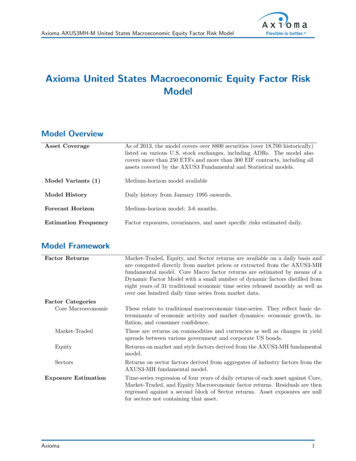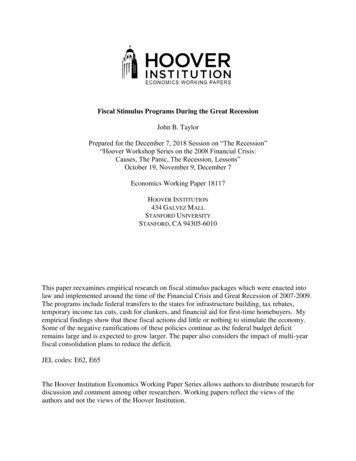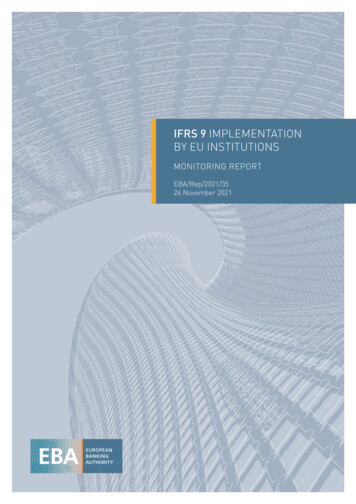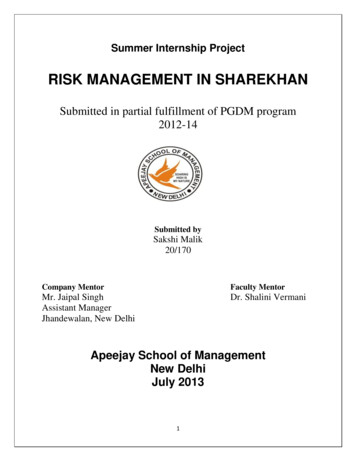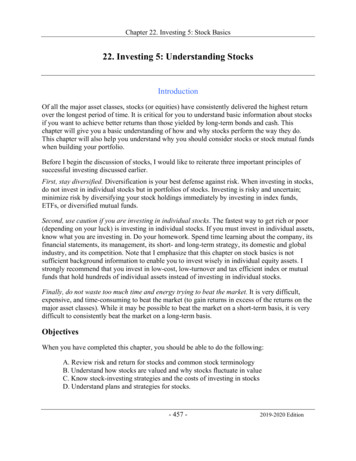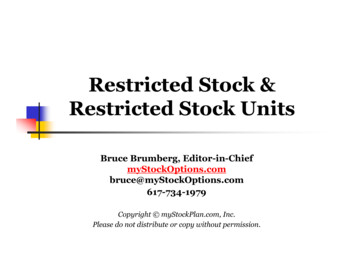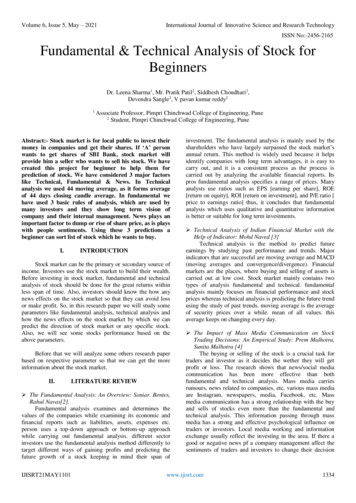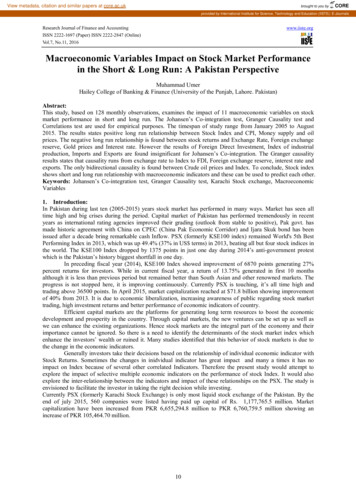
Transcription
View metadata, citation and similar papers at core.ac.ukbrought to you byCOREprovided by International Institute for Science, Technology and Education (IISTE): E-JournalsResearch Journal of Finance and AccountingISSN 2222-1697 (Paper) ISSN 2222-2847 (Online)Vol.7, No.11, 2016www.iiste.orgMacroeconomic Variables Impact on Stock Market Performancein the Short & Long Run: A Pakistan PerspectiveMuhammad UmerHailey College of Banking & Finance (University of the Punjab, Lahore. Pakistan)Abstract:This study, based on 128 monthly observations, examines the impact of 11 macroeconomic variables on stockmarket performance in short and long run. The Johansen’s Co-integration test, Granger Causality test andCorrelations test are used for empirical purposes. The timespan of study range from January 2005 to August2015. The results states positive long run relationship between Stock Index and CPI, Money supply and oilprices. The negative long run relationship is found between stock returns and Exchange Rate, Foreign exchangereserve, Gold prices and Interest rate. However the results of Foreign Direct Investment, Index of industrialproduction, Imports and Exports are found insignificant for Johansen’s Co-integration. The Granger causalityresults states that causality runs from exchange rate to Index to FDI, Foreign exchange reserve, interest rate andexports. The only bidirectional causality is found between Crude oil prices and Index. To conclude, Stock indexshows short and long run relationship with macroeconomic indicators and these can be used to predict each other.Keywords: Johansen’s Co-integration test, Granger Causality test, Karachi Stock exchange, MacroeconomicVariables1. Introduction:In Pakistan during last ten (2005-2015) years stock market has performed in many ways. Market has seen alltime high and big crises during the period. Capital market of Pakistan has performed tremendously in recentyears as international rating agencies improved their grading (outlook from stable to positive), Pak govt. hasmade historic agreement with China on CPEC (China Pak Economic Corridor) and Ijara Skuk bond has beenissued after a decade bring remarkable cash Inflow. PSX (formerly KSE100 index) remained World's 5th BestPerforming Index in 2013, which was up 49.4% (37% in US terms) in 2013, beating all but four stock indices inthe world. The KSE100 Index dropped by 1375 points in just one day during 2014’s anti-government protestwhich is the Pakistan’s history biggest shortfall in one day.In preceding fiscal year (2014), KSE100 Index showed improvement of 6870 points generating 27%percent returns for investors. While in current fiscal year, a return of 13.75% generated in first 10 monthsalthough it is less than previous period but remained better than South Asian and other renowned markets. Theprogress is not stopped here, it is improving continuously. Currently PSX is touching, it’s all time high andtrading above 36500 points. In April 2015, market capitalization reached at 71.8 billion showing improvementof 40% from 2013. It is due to economic liberalization, increasing awareness of public regarding stock markettrading, high investment returns and better performance of economic indicators of country.Efficient capital markets are the platforms for generating long term resources to boost the economicdevelopment and prosperity in the country. Through capital markets, the new ventures can be set up as well aswe can enhance the existing organizations. Hence stock markets are the integral part of the economy and theirimportance cannot be ignored. So there is a need to identify the determinants of the stock market index whichenhance the investors’ wealth or ruined it. Many studies identified that this behavior of stock markets is due tothe change in the economic indicators.Generally investors take their decisions based on the relationship of individual economic indicator withStock Returns. Sometimes the changes in inidvidual indicator has great impact and many a times it has noimpact on Index because of several other correlated Indicators. Therefore the present study would attempt toexplore the impact of selective multiple economic indicators on the performance of stock Index. It would alsoexplore the inter-relationship between the indicators and impact of these relationships on the PSX. The study isenvisioned to facilitate the investor in taking the right decision while investing.Currently PSX (formerly Karachi Stock Exchange) is only most liquid stock exchange of the Pakistan. By theend of july 2015, 560 companies were listed having paid up capital of Rs. 1,177,765.5 million. Marketcapitalization have been increased from PKR 6,655,294.8 million to PKR 6,760,759.5 million showing anincrease of PKR 105,464.70 million.10
Research Journal of Finance and AccountingISSN 2222-1697 (Paper) ISSN 2222-2847 (Online)Vol.7, No.11, 2016www.iiste.orgTable 1 Profile of Pakistan Stock otal Listed Companies1445New Companies Listed41.429.547.6Fund Mobilized (PKR in Billion)496,000.0 1,116,005.01,100,340.9Listed Capital (PKR in Million)2,801,000.0 5,154,738.06,655,294.8Total Market Capitalization (PKR in Million)319.6221.0229.1Average Daily Shares Volume (Million)Source: Economic Survey of Paksitan . Hypotheses Formulation:In literature, the relationship between the economic indicators and stock returns was widely discussed andPakistan experience might not be exceptional. We hypothesized each independent variable’s relationship withdependent variable as follows: CPI and stock returns hypothesis is based on the Dividend Discount Model. Theyargued that inflation rate is negatively associated with nominal rate of return. As increase in nominal rate ofreturn will ultimately increases the discount factor of the model. In asset (stock) valuation process, the higher ofdiscount factor results the lower of asset (stock) value and vice versa. It might be argued that increase in inflationalso bring the increase in cash flows relating to asset and would negate the impact of each other. But the cashflows may not go up with inflation as the pre-existing contracts would deny any immediate adjustments in thefirm’s revenues and expenses. (R.H., 1991).Filis (2009) examined the relationship among various macro-economic indicators in Greece using VARapproach. He suggested that stock market received negative significant influence from CPI. Moreover shocksfrom the CPI required 3 years to absorb by stock market. Hsieh (2013) results using data from New Zealandstock Market by applying GARCH model, Hsing (2014) results from Estonia stock market, Chen (1986) findingsin US economy and Christopher Gan at el. (2006) results from NZSE40 also depicted the negative relationshipbetween CPI and stock prices. In Pakistani context, few studies were conducted in respect of macro-economicindicators and stock market association, Hauqe at el. (2012) using data from 1998 to 2009, Nishat at el. (2004)by using quarterly data from 1973 to 2002 by applying VECM approach and Sohail at el. (2009) by usingmonthly data from 2002 to 2008, found out the similar inverse relationship.Contrary to above, many researches revealed the positive relationship between CPI and stock market.They argued that nominal rate of interest include the real rate of interest and expected inflation. As nominal rateof interest and inflation move in the same direction so increase in inflation also increase the return from stocks.Hence real assets like shares provide hedge against inflation (Fisher, 1930).Patel (2012) carried out a study which showed the impact of selected macro-economic indicators on twostock markets namely Sensex and S&P CNX Nifty using VECM approach for empirical purposes. His findingsstated the positive co-integration between CPI and stock market index. Moreover the studies of (Venkatraja,2014; Kumar, 2014; Adam at el. 2008; Shahbaz at el. 2013) have found significant positive relationship betweeninflation and stock returns. However the results of Imran at el. (2010) and Arshad at el. (2008) are insignificant.Our hypothesis is based on Dividend discount model.Researchers have controversy about the relationship between stock market index and money supply.Some researcher suggested that money supply and stock returns are negatively related as money supply causesinflation which will ultimately increases the discount rate. The higher discount rate means the lower stock valueand vice versa. Other researcher argued that the increase in money supply also stimulate the cash flows ineconomic activity (corporate earnings effect) will resultantly increases the stock prices (Chaudhri at el. 2004).Asmy at el. (2010) conducted a research in Malaysia to find the effects of economic indicator in pre(1987-1995) and post (1999 to 2007) crisis period. He found negative co-integration between Money supply andstock prices in both pre and post crises period. Onneetse at el. (2014) and Rahman (2009) also found the similarresults and confirm the negative relationship between stock prices and money supply.Naik (2013) studied about stock market respondence to economic fundamentals in Indian economy. Thetime period of study was 1994 to 2011 and Vector error correction model used to explore the long termrelationship. He confirmed the positive relationship between money supply and stock prices. Ramin at el. (2004)study in Singapore stock exchange, Patel (2012) study in Indian stock exchange (SENSEX) and Ratanapakorn atel. (2007) study in US economy also confirmed the postivie correlation between the money supply and stockmarket indices.Faisal at el. (2014) and Sohail at el. (2009) also found positive relationship between stock returnsand money supply in Pakistan. We hypothesized the negative relationship between these two.The association of exchange rate with stock returns is depending upon the dominance of economy i.e.import or export dominant. If economy is import dominant then appreciation in local currency will strengthen theeconomy and also show potential of local currency. It will reduce the burden of trade balance. If the economy is11
Research Journal of Finance and AccountingISSN 2222-1697 (Paper) ISSN 2222-2847 (Online)Vol.7, No.11, 2016www.iiste.orgexport dominant then deprecation of local currency will lead to increase in demand for Pakistan’s product andimprove its competitiveness in international market, assuming that demand for exports is sufficiently elastic.Robert (2008) conducted a study for BRIC countries using ARIMA model to explore the relationshipbetween stock returns and macroeconomic indicators. The results revealed the positive association for Brazil,India and China, but in case of Russia negative trend was observed. Donatas at el. (2009) studied about the shortterm relationship between economic variables and stock indices in Lithuania. The results indicated that exchangerate was negatively influence the stock prices in short term. Acikalin at el. (2008) tested the effects of economicindicators on Istanbul stock exchange. The findings indicated that exchange rate could be used to predict thestock prices. Moreover the negative co-integration was observed between exchange rate and stock index.The studies of Mohanamani at el. (2014), Parmar (2013) and Patel (2012) also support the fact thatappreciation in local currency will strengthen the economy while Onneetse at el. (2014) study depicted thenegative relation between these. Moreover Imran at el. (2010) and Izedonmi at el. (2011) studies statedinsignificant findings between these two variables. We hypothesized the positive relationship between exchangerate and stock returns.The various studies argued that interest rate represent the opportunity cost to invest the money inanother interest bearing instruments. Moreover the rise in interest rate also rises the required rate of return (RRR)and in case of asset valuation process, the improved required rate of return will reduce the value of existing stockin market (Mukherjee at el. 2010). While others stated that most of the companies fulfill their financerequirement through borrowings. If the interest rate increases, the cost of borrowings will increases and profitwill decrease automatically. Moreover the substantial buying of stock is made through borrowing so if theinterest rate increase the risk will also increases to lose the money so investor will hesitate to invest.Pramod (2013) tested the relationship between macroeconomic variable and stock returns. No cointegration was found between stock indices and Interest rate in India by using data from 1994 to 2011. Howeverthey found unidirectional causality from interest to stock returns. Quadir (2012) studied about causal relationshipbetween economic indicators and Dhaka stock exchange returns using ARIMA model. His findings negate theabove theory and results. But the coefficient of study was statistically insignificant. Ahmed (2008) studied aboutthe effect of aggregate economic variables on stock prices in Indian economy. He found causality run from stockindices to economic variable in all cases except for interest rate. In case of interest rate the causality move frominterest rate to market indices. Parphan at el. (2002) identified the association between stock indices andeconomic indicators of 5 Asian countries. The results stated that negative long run association exist betweenthese variable in Singapore, Thailand and Philippines. However in case of Indonesia and Malaysia the positiveresult was observed. Our hypothesis suggests the interest as opportunity cost.The enhanced industrial production will increase the firm’s profit and will portray the positive impact ofeconomy in the international market. Moreover the increased production will also improve the balance ofpayment and surplus cash flow will be used to import the necessary items for the economy.Mohanamani at el. (2014) mentioned highly positive correlation between BSE Sensex and index ofindustrial production among the selected group of economic variable. Moreover Index of industrial productionalso showed the highest correlation between IIP and Money supply i.e. 91%. Further no causality was found forIIP. Chittedi (2015) carried out a study in BRIC countries, he found only Index of Industrial production hadimpact on Russian stock market. It is also mentioned that increase in industrial production, the corporate profit oforganization also enhanced that will ultimately impact on the positive view of economy. Vashishtha at el. (2013)found out the moderate correlation between Index of industrial production and Sensex for a period of 2006 to2011. He also found negative relationship between IIP and BSE Sensex. He stated investor must beware whileinvesting and reliable tool used to predict the Index.Ramin at el. (2004) carried out a study in Singapore. He found positive relationship betweenSingapore’s All-S Sector Indices and Index of industrial production. Imran at el. (2010) found the positiveassociation between Index of industrial production (IIP) and stock Indices. He found no causal relationshipbetween macro variables and index. We hypothesized the positive relationship between index of industrialproduction and stock returns.Gold has been considered as a substitute of investment against stocks. Due to less awareness of stocksinvestment in underdeveloped economies, most of the savings are invested in Gold by small investors. Moreoverthe news about Gold prices increment will turn the investment to Gold from stocks which will negatively affectthe stock prices. Gold may also be used as hedge against inflation.Buyuksalvarci (2010) carried out a study in Turkey in which relationship among various economicindicators and stock prices had been determined. The findings stated that Gold price does not have anysignificant impact on stock prices in Turkish economy. Ghosh at el. (2010) results depicted significant impact ofgold prices along with other macroeconomic variables (oil price, dollar price and CRR) on the stock marketreturns. Sharma at el. (2010) findings revealed that gold prices have heavily influence on the stock prices amongthe group of variables. Ray (2012) tested the Granger causality test and multiple regression model to identify the12
Research Journal of Finance and AccountingISSN 2222-1697 (Paper) ISSN 2222-2847 (Online)Vol.7, No.11, 2016www.iiste.orgimpact of different macroeconomic variables on stock market. The empirical results showed that gold price andoil price have significant negative effect on stock returns in India. Hina at el. (2011) conducted the researchregarding the gold and KSE100 index relationship. Johansen’s co-integration test was applied the resultsrevealed that there was long run relationship between gold and KSE100 Index.Sulaiman at el. (2012) judge the positive relationship between KSE100 Index and gold prices usingArbitrage pricing Theory (APT). Dirk G. at el. (2010) carried out a study to analyze that whether gold is hedgeor safe haven against stocks and bonds. The results stated that gold is hedge against stock but safe haven for onlyshorter period of time (15 days) and in extreme time period. The study further indicated that gold is not a safehaven against bonds. So we hypothesized that gold provide hedge against stock movements.Pakistan is the crude oil importing country so the changes in oil prices in international market affect thelocal economy a lot. The changes in Crude oil prices have heavy effect on energy and ultimate effect on cost ofproduction. The high oil prices also reduced the economic activity due to increased cost of production andreduced profit margins. So the future cash flows are affected and share prices of manufacturing industriesfluctuate heavily due to it. (Kumar, 2014)Filis (2009) conducted a comprehensive study in Greece stock market. The main findings suggested thatstock market was negatively influenced by Oil prices. Moreover the oil prices did not have any influence onindustrial production and Consumer price index. Nandha at el. (2008) had been documented the negativerelationship between oil prices and stock returns. They further added that apart from changes in oil prices, the oilprice volatility also impact on the stock price movements. O'Neill at el. (2008) also confirmed the similar resultsin their study. Agren (2006) conducted a study in 5 developed economies to know the impact of oil prices onthese stock markets. They VAR-ABEKK model to examine the results. The results stated that stock markets ownshocks tend to have more impact on stock indices of these countries than the oil prices changes. Maghyereh(2004) identified the relationship between oil market shocks and stock returns in 22 emerging markets. Theresults stated that relationship between oil prices and stock returns was weak in emerging economies as compareto developed economies.Davis at el. (2008) stated that oil prices have negative influence on the stock returns. He further arguedthat determinant of oil price shock, i.e. supply driven or demand driven. The concluded supply driven shock havemore significant impact on the stock prices than demand driven shocks. Negating the results of Davis at el.(2008), Kilian at el. (2007) results stated that demand driven shocks caused negative effects on US stock market.Moreover, they stated that increment in oil prices due to world expansion have positive impact on the stockprices in the US Economy.Although there is not a comprehensive literature backed by the concept of co-integration betweenimport or export and stock returns but there are some studies that used the import or export as an independentvariable among the other economic variable who explained the stock returns. The export of surplus items bringsforeign exchange and increases the profits of export oriented firms. The production capacity of firms enhanced,cash flows increases. Moreover, the import and export oriented economy also have a large impact on othervariables movement like Oil prices, exchange rate etc. Import and export are the main factor for balance ofpayment determination. The favorable and unfavorable balance of payment reflect the economy condition in theinternational market and attract the foreign investments.Faruque (2011) carried out a study in Bangladesh to empiricaly test the Arbitrage pricing theory. Healso used import and export along with the other variables to identify the impact on stock market, the resultsrevealed the negative impact of imports and exports on the stock market. Zhu (2012) and Ruta at el. (2014) alsoconfirmed the results for exports but in case of imports insignificant results were found. However Sohail at el.(2012) findings are contradicts with others. Yavuz (2005) found no causlaity in either direction. Wehypothesized positve and negative relationship with exports and imports respectively.Foreign exchange reserves create the strong position of the country to intervene in the internationalmarket for imports payment and to balance the exchange rate. Mookerjee at el. (1997), Maghayereh (2003) andTurgut at el. (2008) found the long run association of FXR with stock returns. Rahman at el. (2009) and Hussainat el. (2012) concluded the positive relationship while Akbar at el. (2012) and Onneetse at el. (2014) suggestedthe negative relationship between FXR and Stock returns.The role of foreign Direct Investment in country depending upon its nature whether it’s have acomplementary role or substitution role in the host economy. If FDI acts as a substitution then negative impact isexpected as it will adversely affect the existing corporate structure, financial etc. It will also increase the level ofcompetition. On the other hand, If FDI acts as a complementary then positive impact is expected as it remove thescarcity of capital, technology, managerial skills, human capital etc. As Pakistan is emerging economy, socomplementary role is expected (Shahbaz at el., 2013).Pilinkus (2010) analyzed the impact of 10 major economic indicators on Baltic State’s (Lithuania,Latvia and Estonia) stock market performance. These indictors explained proportionately 37%, 39.9% and36.4% fluctuations of stock market indices of Lithuania, Latvia and Estonia respectively. The results more13
Research Journal of Finance and AccountingISSN 2222-1697 (Paper) ISSN 2222-2847 (Online)Vol.7, No.11, 2016www.iiste.orgrevealed that FDI (lagged by one period) is significant in case of Lithuania and FDI (lagged by two period) issignificant in case of Lithuania and Latvian states. Ahmed (2008) results revealed that foreign direct Investment(FDI) have long run association with Nifty stock Exchange while in case of Sensex no long run association havebeen depicted in study. The results of Hetamsaria (2008), Adam at el. (2008), Babayemi at el. (2013) AlHalalmeh at el. (2010) and Shahbaz at el. (2013) concluded the postive co-integration in different economies.Kumar (2014) used 164 monthly observations to investigate the dynamic relationship between Indian stockmarket and its determinants. He found that long run association of foreign direct investment with stock marketperformance was not supported by data and its co-integration coefficient was found insignificant. Issahaku, H. atel. (2013) conducted another study in Ghana to know the causal relationship between economic indicator andstock returns. His findings stated significant relationship between stock returns (Index) and foreign directinvestment (FDI).3. Research Methodology:The study is conducted to identify the impact of macroeconomic variables on stock market performance inemerging economy. The time series data is used which is based on 128 monthly observations consisting of 10years from January 2005 to August 2015. We use the analytical research methodology as facts and figures arealready available and we only analyze those to make our judgment on the basis of that data. This study isconducted in non-contrived settings as all data is collected from natural environment. As well as the time horizonis concerned, it is a cross sectional study as data is collected in one shot. For empirical purposes we use thesecondary data, collected from various recognized and reliable resources namely Monthly Bulletins of PakistanBureau of Statistics, Statistical Bulletins of State Bank of Pakistan, Economic Survey of Pakistan and WDI(World Development Indicators).The data is available in different units of measurement. We convert all data inLogs expect Foreign Direct Investment because FDI consists of some negative values and if we convert thosevalues cannot be converted into logs and these will excludes from the data. Moreover, we convert the databecause original values create long residuals in calculations and bigger chances of errors in results. So weconvert all the variables. The data consists of 11 independent variables and 1 dependent variables. The Table 2describes the symbols, variables used, their units of measurements and variables used as proxy for empiricalpurposes.Table 2 Description of DataSymbol VariableUnits of Measurement ProxyInflationIndex (2004-05 100)Consumer Price IndexCPIMoney SupplyPKR BillionBroad MoneyM2Exchange RatePKR/US DollarMonthly Average Rupees/US EXRInterest RatePercentagesWeighted Average Deposit RateINRIndex of IndustrialIndex (2004-05 100)Quantum Index of Large ScaleIIPproductionManufacturingPKR/10 GramsKarachi Average Price Rupees/ 10 gramsGOLD Gold PriceOil PriceUS /BarrelInternational Crude Oil priceOILImportsUS millionAmount of monthly importsMExportsUS millionAmount of monthly exportsXForeign Exchange ReserveUS millionGold & Foreign Exchange ReserveFXRForeign Direct InvestmentUS millionForeign Private Direct InvestmentFDIIndex (1991 1000)KSE100 Index (Currently PSX)INDEX Stock ReturnsThere are various techniques used for empirical purposes to know the long run and short runrelationship between macroeconomic indicators and stock returns as well as other correlation techniques are used.Before applying Co-integration, we check whether data is Stationary or not. The OLS regression resultsmight deliver the spurious regression if the data series don’t stationary. Stationary data series means that firstlyits mean & variance are constant overtime, secondly its value of covariance between two time intervals dependsonly on the distance between two time intervals and not on the actual time at which it is computed.Stationary Test: To check data is stationary or not, we use Augmented Dicky Fuller Test. The ADF test havethe null hypothesis (H0) that time series exists the unit root (Non Stationary data) and alternative hypothesis (H1)that unit root does not exist (Stationary data). If the critical value is more than the ADF test statistic, then the nullhypothesis (H0) is rejected means data stationary or otherwise accepted. If the data is stationary at level then thetest will be attempted at first difference and afterward second difference.Correlation: Correlation test has been applied to identify the multi-collinearity among the variables. Thecorrelation coefficient lies between -1 to 1. If correlation coefficient -1, it means the prefect negative correlationexist between both variables or vice versa. On the other hand, if correlation coefficient is greater than 0.8 itreveals the multi-collinearity between variables.14
Research Journal of Finance and AccountingISSN 2222-1697 (Paper) ISSN 2222-2847 (Online)Vol.7, No.11, 2016www.iiste.orgCo-integration Test: For identifying the long run relationship between Macroeconomic variables and stockreturns. For this purpose, we applied the Johansen’s co-integration test (Johansen & Juselius, K., 1990). UnderJohansen co-integration approach two test statistics can be used i.e. Trace Statistic and Maximum Eigenvaluestatistic. The trace test can be formulated as:Where r represent the number of co-integrating vectors, k is the number of variables in group, λi is the i thlargest eigenvalue of the matrix Π, and T is the number of observations in the system. The hypothesis of Tracetest is as follows:H0: The number of distinct co-integrating vector(s) is equal to or less than rH1: The number of distinct co-integrating vector(s) is more than rThe Maximum Eigenvalue can be formulated as:λmax (r, r 1) -T ln(1- λ r 1)(2)The hypothesis of Maximum Eigenvalue test is as follows:Ho: The Number of co-integrating vector is rH1: The number of co-integrating vector is r 1ModelTo examine the long run relationship between macroeconomic variables and KSE100 Index, the followingeconometric model is specified.LINDEX β0 β1LCPI β2LM2 β3LEXR β4LINR β5LIIP β6LGOLD β7LOIL β8LM β9LX β10LFXR β11FDI εtGranger Causality: In last the Granger Causality test is applied to establish the short run relationship betweenstock returns and macroeconomic indicators. This test is proposed by the C. J. Granger in 1969. If the computedvalue of F Statistic exceeds the critical value, the null hypothesis is rejected at given level of significance. TheGranger cause state that the variable can be used to predict each other.4. Empirical Results:For identifying data normality various techniques like Kurtosis, Jarque-Bera and Skewness is used. These testcheck that whether data is normally distributed or show randomness.Table 3 Descriptive 480.282823.214940.9Std. 60.0000.000Table 3 depicts the results of Data normality. The results of skewness reveal that Foreign directinvestme
This study, based on 128 monthly observations, examines the impact of 11 macroeconomic variables on stock market performance in short and long run. The Johansen's Co-integration test, Granger Causality test and . indicators and stock market association, Hauqe at el. (2012) using data from 1998 to 2009, Nishat at el. (2004)
